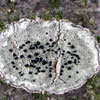What is a Lichen?
'A lichen is a partnership between a fungus and at least one alga or cyanobacterium ('blue-green alga')' (Purvis, 2006)

The fungus is unique to each lichen species whereas the same photosynthetic partner is found in many different lichens.
A lichen develops when a fungus (the mycobiont) and an alga (the photobiont) grow together to form a symbiotic relationship which leads to a unique organism. The photosynthetic activities within the algal cells provide nutrients for the lichen to grow.
Lichens can be found in the most inhospitable habitats but are also considered amongst the most sensitive of living organisms to change in atmospheric gas composition and to climatic stress. They grow very slowly. Some are highly selective in their habitat whereas others colonise many different substrates.

Lichens look most interesting when viewed through a magnifying glass, hand lens or microscope. It is helpful to take a photographic guide out with you and lichen keys will help with identification.
Lichens look most interesting when viewed through a magnifying glass, hand lens or microscope. For futher information about lichens please contact the British Lichen Society or the Natural History Museum.
Go back to the Biomonitoring page.
References Hawksworth, D.H. (1988) Horizons in Lichenology. The British Lichen Society.

